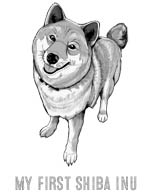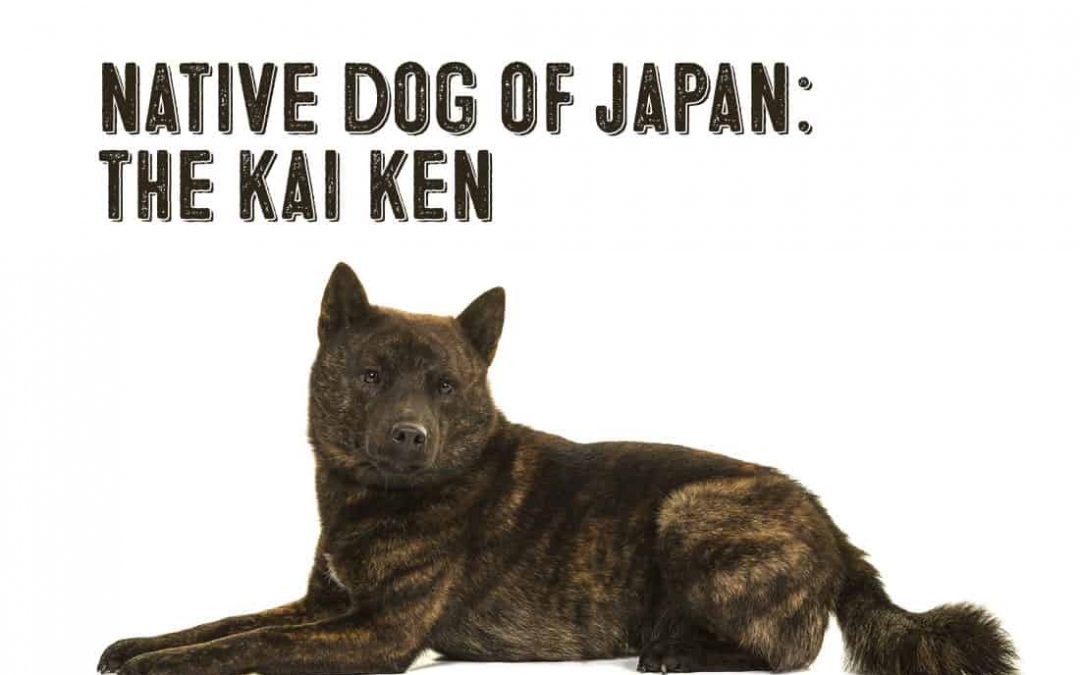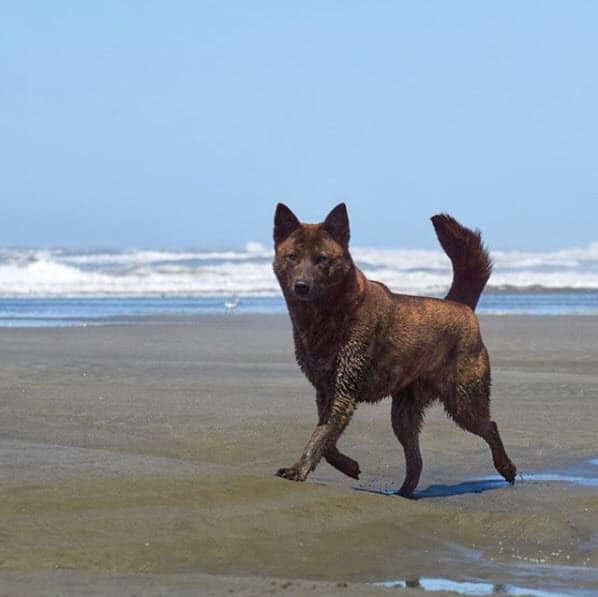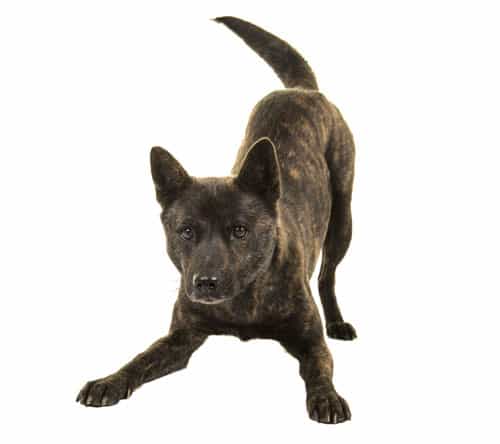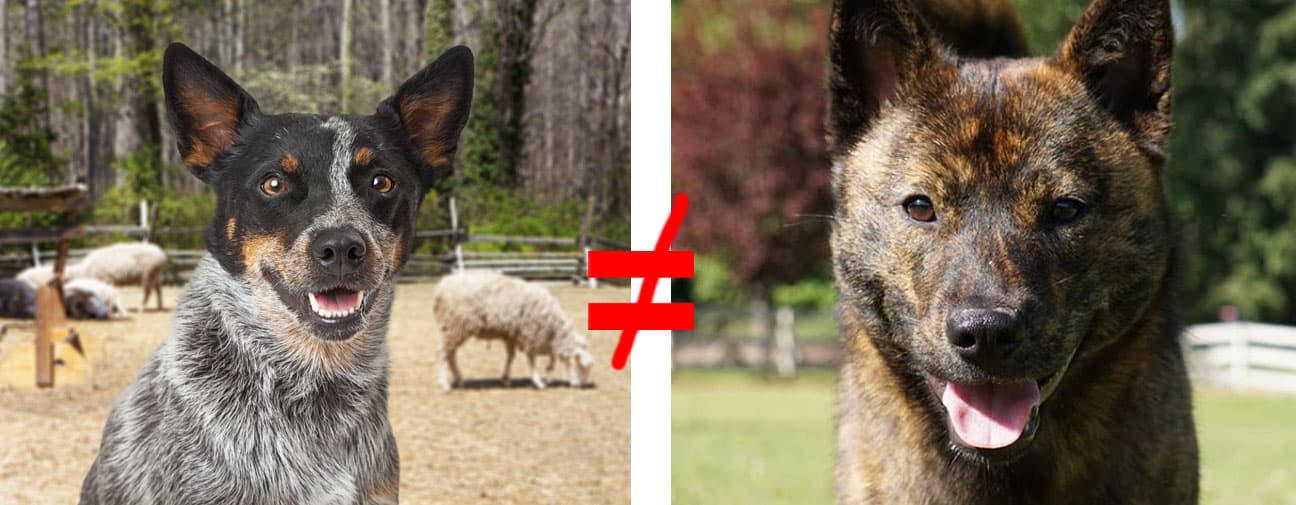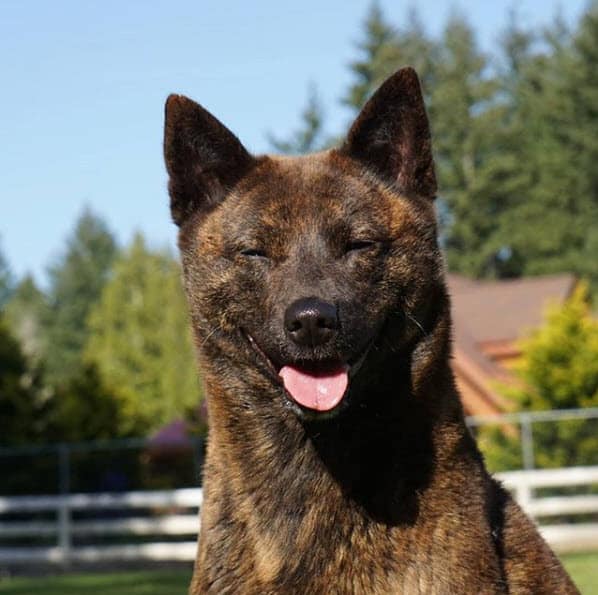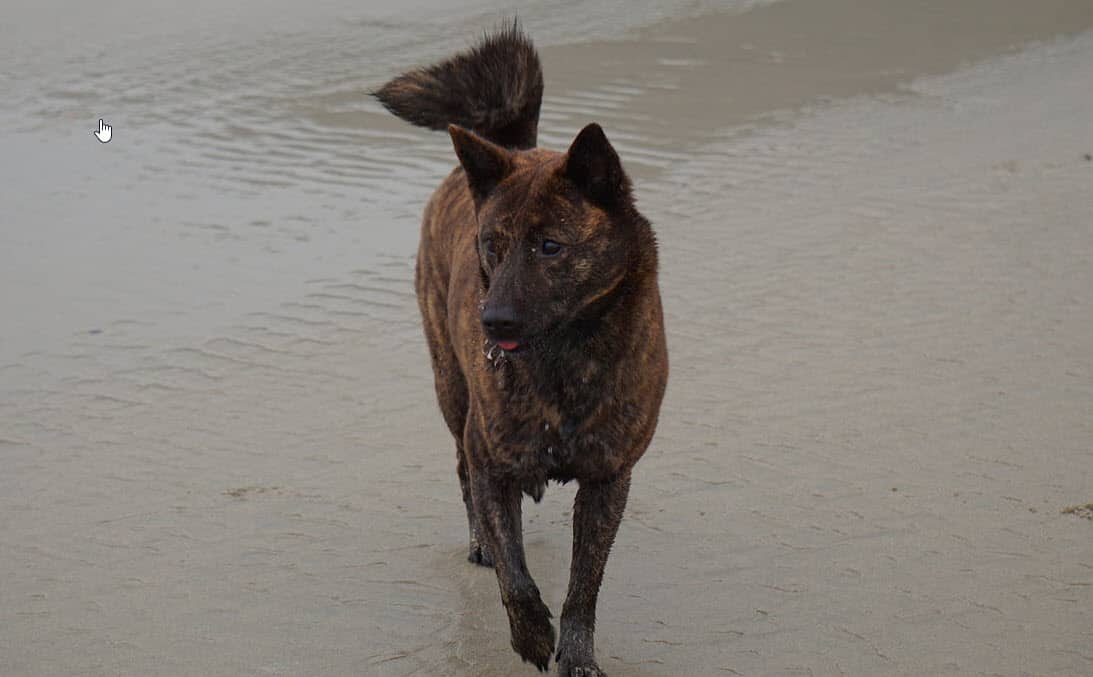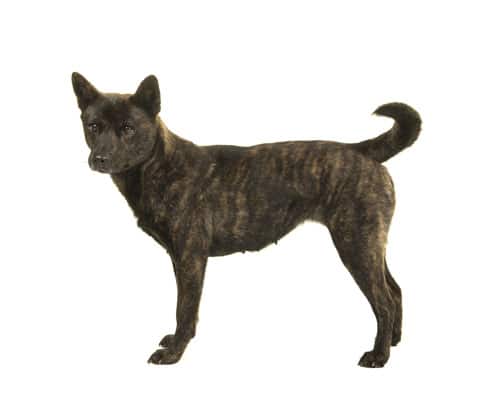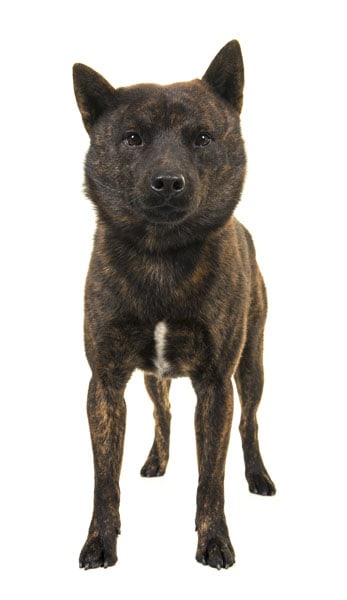Out of the six recognized native dog breeds of Japan, the Kai-Ken, also known as the Tora Inu (Tiger Dog) is the most atypical looking of the bunch.
While the five other dog breeds have similar fox / wolf-like features, the Kai-Ken, with it’s brindle color coat has a bit more of a German Shepherd look – with a “touch” of wolf.
Nevertheless, the Kai-Ken is a handsome medium-sized dog with a svelte, but muscular body capable of impressive physical feats.
As you learn more about the Kai dog breed, it is important to understand that even in Japan, the Kai is a very rare dog breed.
Beautiful Kai Ken Dog – Hayaikaze
Sadly, the Kai along with the three other medium-sized indigenous Japanese dogs are now considered at risk for extinction.
Yearly registrations of the medium-sized breeds have plummeted from a high of 5100 in 1989 to a low of 689 in 2018.
That means, even in their own native homeland, the chance of actually seeing a Kai or any other medium-sized Japanese dog breed is close to nil.
The Kai is a primitive breed of dog that is only suitable for certain dog owners that understand the temperament and needs of primitive dog breeds.
They are not suitable for all families – they are solely suitable for the “right” families.
Kai Ken Belgium – Takai kennel
Cool Kai Fact
Did you know that former first lady Nancy Reagan once fostered and saved the life of a Kai puppy?
And that puppy went on to become a movie star?
It’s true.
In 2003, by happenstance, Nancy Reagan came across a sickly and starving puppy, barely a few weeks old, on the streets of L.A.
Nancy and Ronald immediately rushed the puppy to a vet, where it was successfully treated for Parvovirus – a potentially deadly disease.
The healthy puppy, named Little Bear was then ready to find his forever human, who turned out to be Bryan Michael Stoller, a Hollywood screenwriter, producer and director. The rest is movie history.
Australian Cattle Dog on left, Kai Ken on right… similar but not the same breed
Stoller wrote, produced, and directed the 2010, children’s hit movie “First Dog”, after being inspired by Little Bear’s amazing story as well as his natural performance abilities and eagerness to please.
Stoller got to visit the Reagans and Nancy was so amazed that the little “bear” puppy she rescued went on to be a Hollywood star – just like her husband and our former President of the United States!
Amazingly, for over seven years, Stoller taught that his little bear was an Australian Cattle Dog. After the movie was released, Kai breeders and fanciers informed him that Little Bear has Japanese and not Australian origins.
How cool is that? Little Bear, an extremely rare Japanese Kai gets rescued by Nancy Reagan and then becomes a Hollywood Pooch!
Kai Ken Appearance
Adorable Kai Ken Puppy – Hayaikaze
The Kai Ken is the smallest of the medium sized native Japanese dog breeds. Being a spitz-type dog, the Kai sports a wedge-shaped head, prick ears, and a curled or sickle tail.
The body of a Kai is sturdy, muscular, and well balanced. Due to the rugged and hilly terrain of the Kai’s origins – the Kai has powerful limbs and well-developed hock joints.
Male Kai dogs are between 18 to 22 inches tall (at the shoulder), while female Kai stand between 17 – 20 inches. This makes the Kai just slightly taller than a Shiba Inu by a few inches.
Males weigh up to 50 pounds with females weighing up to 45 pounds. So weight-wise a Kai is roughly double the weight of a Shiba Inu.
These size standards vary depending on which of the organizations it is derived from.
Organizations that recognize the Kai include the JKC, Nippo, KKA (Kai Ken Aigokai), and the FCI.
The Kai has a double coat with a harsh and straight outer coat and thick under coat.
The unique brindle coloring of a Kai is the breeds most distinctive feature.
Kai Ken Dog with brindle markings – Hayaikaze
There are three recognized brindle coat colors for the Kai that include black brindle (kuro-tora), medium brindle (chu tora), and red brindle (aka-tora). Of the three, black brindle is the most genetically dominant and red brindle is the rarest.
Occasionally, a recessive gene can produce a non-standard cream, or white colored Kai.
Interestingly, most Kai have dark spotting on their tongues potentially indicating a relationship to the Chow Chow.
Kai puppies are quite the charmers and born with black, fuzzy coats. The brindle color continues to develop and evolve as the Kai ages. It can take as long a five years for a brindle coat to finish.
In terms of conformation, the black areas of the brindle should be “soft” and not sharply edged.
Kai Ken Temperament
The Kai shares many of the same personality traits as the other native Japanese dogs. They are intelligent, independent, and alert.
The Kai still possess a strong instinct to hunt and at times can be territorial.
Like earlier mentioned, the Kai Ken is a primitive dog and not a dog for everyone.
The Kai usually is a one-owner dog and will form a strong bond with its master. So strong it said – that the Kai would protect his master at all costs.
This intense bonding also makes Kai a more difficult dog breed to train as the Kai will only readily take commands from his owner.
The Kai dog is a naturally shy dog breed that needs A LOT of socialization when young. They are loyal and affectionate to their family while cautious of strangers.
By nature, Kai Ken are pack dogs more so than the other Japanese breeds. This may explain why their bloodline has remained relatively pure for all of these centuries.
Being pack dogs, they generally can get along well with other dogs provided they were correctly socialized.
But due to their extremely high prey drive, should not be left alone with smaller animals until you’re certain of their intentions.
Kai Ken Health
The Kai is a relatively healthy dog with a lifespan between 12-15 years.
There is currently only limited data regarding possible genetic issues with the Kai breed.
Some issues that have been noticed in Kai include luxating patella, hypodontia, seizures, allergies, and cryptochidism.
Because of a Kai’s strong instinct to hunt and work – equal attention must be given to a Kai’s mental health.
Kai’s should be given daily exercise and mental stimulation. These physical demands alone show another example of why the Kai Ken is not a dog for every owner.
History of Kai Ken
The Kai Ken originated from what is now known as Yamanashi Prefecture, Japan. This area was originally known as Kai no Kuni which is where the Kai’s name came from.
In fact, five out of the six native Japanese dog breeds are named from area of their origins – with the Shiba Inu being the outlier.
Eventually the Kai spread to the Southern Japan Alps and encountered rugged terrain isolated from outsiders.
For the hunting families that inhabited this inhospitable terrain – their very survival depending on their hunting expeditions that the Kai took part in.
It has been mentioned that the Kai has been a mostly feral dog breed until quite recently in history when hunters of the region discovered the Kai’s excellent hunting abilities.
The Kai eventually became domesticated and reliable working dogs that were revered by their families.
A Kai’s brindle coat is said to have developed to help the Kai blend into the environment further enhancing their chance of hunting success.
Kai Ken Dog at the beach – Hayaikaze
Kai Ken will even climb trees or jump in the water in the relentless pursuit of their prey. For this reason alone, a Kai dog should not be trusted off leash.
Traditionally, the Kai was used to hunt Kamoshika, a type of antelope.
Hunters soon discovered that the Kai’s remarkable athleticism made the dog suitable to hunt a wide range of prey, from small pheasants to small bear.
At one point, Kai were further categorized by the type of game they were trained to hunt – either wild boar Kai, or deer kai.
The wild boar Kai or Shishi-Inu had a stockier body and bear like face while the deer Kai, or Shika-inu had a svelte body and fox-like face.
In current modern times, the Japanese do not distinguish between the two as both types were equally important in further developing the breed.
In the early twentieth century, Japan opened up to the outside world and western influences – as well as western dogs begin to infiltrate the country.
The Movement To Preserve Japanese Dog Breeds
Eventually, concerned citizens realized the need to preserve their beloved native dogs from interbreeding.
One particular citizen, Dasuke Adachi became particularly impressed with the Kai dog and began his research to locate more of these dogs.
His research proved fruitful and thanks to the isolated area where the Kai inhabited, he and his small team were able to bring back two nice Kai dogs with pure blood lines back to the city.
From there, the Kai Ken Aigoakai (Kai preservation group) was formed and interest in the Kai dog spread.
Kai Ken Belgium – Takai kennel
By 1933, the Kai dog became the first of the medium sized native breeds to be declared a Natural Monument by the Japan government.
With national and prefectural government protection, the numbers of Kai dogs gradually increased. Kai dog owners were even given tax breaks just for owning one of these treasured dogs.
Fortunately due to these protections, the Kai Ken was able to survive World War II relatively unharmed.
Tragically, the other native breeds like the Akita and Shiba Inu were almost completely wiped out.
Thankfully, with much effort and perseverance, Japanese native dog preservationists were able to save the remaining five native dog breeds.
Fast forward to 2019, and unfortunately four out of the six Japanese dog breeds are once again facing extinction.
All four of the medium – sized Nihon Ken have seen their registration numbers in Japan drop dramatically. From 5,100 in 1989 to 689 in 2018.
The main reasons for this drop is the simple fact that these medium-sized dog breeds are too big for the majority of the citizens of Tokyo – Japan’s most populous city.
Instead, Tokyoites are opting for smaller western breeds like the mini poodle, daschunds, and chihuahuas.
Even their own native small-sized Shiba Inu is a bit too big for the typical Tokyo home environment.
Tain Rose, a dedicated Kai Ken breeder and preservationist from Western Washington states that the Kai is not as adversely affected as the other medium sized native breeds – with the Kishu suffering the most.
With the help of other dedicated Kai breeders, she feels optimistic about the Kai’s future. She is currently working on a new Kai Ken of America website as well as breed standards.
Hopefully, the Japanese government can once again bring the numbers of their treasured national monuments up.
Only time will tell and awareness is the first step at tackling an issue of this magnitude.
Kai Ken Belgium – Takai kennel
Interview With Tain Rose – Kai Ken Breeder, Enthusiast, Preservationist
What traits make the Kai Ken different from the other native Japanese dog breeds?
Tain: “What sets Kai Ken apart from the other Japanese breeds is they choose flight over fight in most situations. This makes people call them sensitive, but I believe it to be more self preserving. They don’t actively look for or engage in conflict. Which is great when people have shibas who are pretty testy, they can get a Kai Ken who won’t push buttons and will respect the boundaries of other dogs. They’re also not as ‘stubborn’ as other breeds. They can have a bit of sass but are easily motivated once you find what motivates them (treats, toys, etc). But they are very much a dog that wants to work *with* you, not for you. So you also have to be invested, interested, and engaged in whatever you’re trying to accomplish! If you’re not having fun, they’re definitely not having fun.”
Would you know an estimated number of FSS Kai Ken registrations in the United States?
Tain: “I think there is about 100 AKC FSS Kai Ken in the US, however a large portion of Kai Ken are registered UKC or not even registered unfortunately. I believe we have a total population of 300-400, which is much better than the less than 50 kishu. We also have a larger number of dedicated breeders.”
What kind of owner / family does a Kai require?
Tain: “Kai Ken will excel with motivated and active persons. They’re usually ready to do anything, as long as it is with you! However they are quite cat like so if you’re interested in a new activity (for example I’m training dockdiving with Kurisu right now) make sure to take it slowly with them until they’re confident. Kurisu loves the water but every pool is different and she doesn’t feel confident at each individual pool until she has visited it a couple times, which makes sense! Doesn’t sound very smart to jump into an unknown body of water lol. So treat each scenario as a new one until you know what your pup can handle, and even then probably error on the side of caution. Kai Ken are very impressionable– my dad chased Tavi has a puppy (think about it– her first time meeting him and she is 5lb, he is 200lb+) and she did not define it as a good time. To this day, 5 years later, she’ll say hello and lick his hand but then excuse herself to the bedroom because she does not prefer his company. So to add to this, if you have a routine or you know that every year you take a week or two week long trip or you do lots of car rides, start preparing early! You need to get them used to these expectations from the start so it’s not a shock when you suddenly take a 6 hour car ride when you’ve only ever been in the car for 20 minutes at a time. While they’re active, they’re not in dire need of running multiple miles a day. I’ve had more success with mental stimulation tiring my dogs out. From personal experience I can say they will happily hike 15 miles up a mountain like it’s nothing. But 30 minutes of herding sheep and they sleep for days!”
Do you recommend following the “pack theory” method for the Kai?
Tain: “I definitely would not use “alpha” or “dominance” theory type stuff with Kai Ken. Kai Ken, even as puppies, take awhile to bond to their owners. Sure they will follow you around and take treats but you have to earn their trust and bond. I don’t think my bond with Tavi solidified until she was about 1.5 years old (she’s 5.5 now). I kept her daughter, Kurisu, back from her litter and we’re still figuring out our bond even though I’ve been holding her since day 1. But maybe bond means something different to me– I can 100% put my faith in Tavi and I know exactly how she will react and what she wants and doesn’t want. We’re on the same wavelength and have fluid communication. Using harsh or aversive techniques can damage this bond– just as putting them in negative or stressful situations where they might not trust your judgement anymore. It’s hard because there is a fine balance.. sometimes I do have to play the bad cop and insist on nail trims but I can tell when they’re actually scared vs being a brat (which nihon ken can be, I believe that is what a lot of the Shiba screaming videos are– shibas throwing fits because it gets the desired outcome for them, they’re working the system).”
How difficult is it to bring a Kai Puppy home?
Tain: “Finding a breeder won’t be much of a hassle, there’s quite a few of us. However expect to wait 1-3 years for a puppy as litters are small (I’d say average is 4) and many of us don’t breed often. I’ve flown puppies and have driven them to their new homes– but I wouldn’t say a Kai Ken puppy is different than any others when they’re so young. They’ll frequently need to potty, eat 2-3 times a day, and make every situation positive and fun with lots of treats.”
Follow Tain Rose and her beautiful Kai Ken at:
https://kai-ken.weebly.com/links.html
https://www.instagram.com/omgtain/
More Information on the Kai Ken:
http://www.kai-ken.org/index.htm
http://hellokennel.com/Breed.php
https://rogueriverkai.org/kaiken
https://www.nihonken.co.uk/kai-ken/
Kai Ken Belgium – Takai kennel
Thanks for visiting Myfirstshiba.com! We do our very best in providing our readers with awesome content about our beloved Shiba Inu breed. Some of our articles include reviews and recommendations to our favorite products. We do occasionally earn commissions from certain affiliate links that help support our work and mission. Thanks again for visiting. Shiba Kisses To All!
